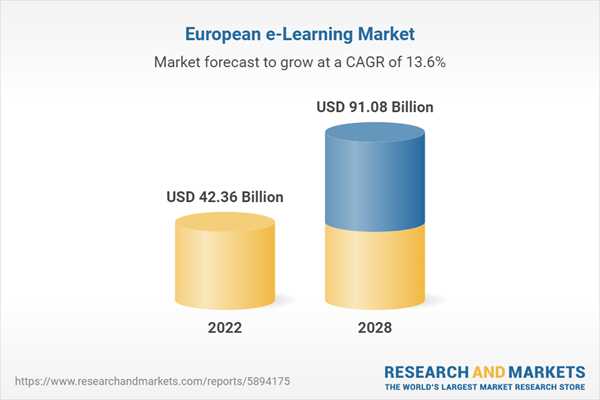Speak directly to the analyst to clarify any post sales queries you may have.
KEY HIGHLIGHTS
- The availability of topic competence examinations and certificates propels the e-learning business in Europe to new heights. E-learning course assessments help determine a learner's degree of topic competency. They also aid in raising awareness of students' progress in grasping a given concept.
- Learners can also use e-learning courses to revisit areas of the subject matter if they did poorly during the exam. Learners receive certifications Upon completing their e-learning courses and passing the examinations. Learners can strengthen their credentials for future employment by earning certifications in specific disciplines. Regular reviews of topic knowledge efficiency and certifications propel the market forward over the forecast period.
- Europe has been at the forefront of several innovations in education, consumer goods manufacturing, and artificial intelligence, including internet infrastructure. Consumers in Europe, mainly the government and corporate segments, are interested in adopting paid E-learning subscriptions. They are also actively engaged in training and testing functions to improve the overall productivity of employees. The trend is to invest in E-learning subscriptions and online courses or digital universities, creating opportunities for higher revenues for E-learning vendors.
- Europe is a value-oriented education market. Consumers explore different ways to manipulate their budget but do not compromise on the quality of learning. Consumers usually check out other platforms and learn values from traditional and online platforms. The effects of Brexit are visible throughout Europe and the UK. Although consumers in Central Europe are particular about their finances, they are not ready to trade off their lifestyle with cheaper alternatives, which creates a higher demand for e-learning courses, even if they are free in Central and Eastern Europe.
- During the projection period, the European e-learning industry faced challenges due to the high development costs associated with e-learning courses. The selected instructional design methodology determines the cost of developing and designing e-learning courses. As a result, developing e-learning courses for various target learner groups are expensive.
- The development process necessitates the involvement of subject matter experts (SMEs), instructional designers, project managers, and technical staff specialists, all of whom incur substantial variable costs. As a result, the high development costs connected with e-learning courses limit the market's growth.
SEGMENTATION & FORECAST
- Delivery Mode (Revenue)
- Packaged Content
- Learning Management System (LMS)
- Others
- Learning Mode (Revenue)
- Self-paced
- Instructor-led
- Function (Revenue)
- Training
- Testing
- End-User (Revenue)
- Corporate
- Higher Education
- K-12
- Government
- Vocational
MARKET STRUCTURE
- Market Dynamics
- Competitive Landscape of Europe E-Learning Market
- Key Vendors
- Other Prominent Vendors
APPENDIX
- Research Methodology
- Abbreviations
- About the Analyst
LIST OF VENDORS
Key Vendors
- Oracle
- Adobe
- British Council
- Aptara
- Pearson
- Skillsoft
- Anthology
- Coursera
- Cisco
- BYJU’S
Other Prominent Vendors
- GP Strategies
- McGraw Hill
- D2L
- Cengage Learning
- NIIT
- Learnetic
- IXL Learning
- Udemy
- edX
- Docebo
- Litmos
- LeQuest
- FutureLearn
- iHASCO
Table of Contents
Companies Mentioned
- Oracle
- Adobe
- British Council
- Aptara
- Pearson
- Skillsoft
- Anthology
- Coursera
- Cisco
- BYJU’S
- GP Strategies
- McGraw Hill
- D2L
- Cengage Learning
- NIIT
- Learnetic
- IXL Learning
- Udemy
- edX
- Docebo
- Litmos
- LeQuest
- FutureLearn
- iHASCO
Methodology
Our research comprises a mix of primary and secondary research. The secondary research sources that are typically referred to include, but are not limited to, company websites, annual reports, financial reports, company pipeline charts, broker reports, investor presentations and SEC filings, journals and conferences, internal proprietary databases, news articles, press releases, and webcasts specific to the companies operating in any given market.
Primary research involves email interactions with the industry participants across major geographies. The participants who typically take part in such a process include, but are not limited to, CEOs, VPs, business development managers, market intelligence managers, and national sales managers. We primarily rely on internal research work and internal databases that we have populated over the years. We cross-verify our secondary research findings with the primary respondents participating in the study.

LOADING...
Table Information
| Report Attribute | Details |
|---|---|
| No. of Pages | 83 |
| Published | October 2023 |
| Forecast Period | 2022 - 2028 |
| Estimated Market Value ( USD | $ 42.36 Billion |
| Forecasted Market Value ( USD | $ 91.08 Billion |
| Compound Annual Growth Rate | 13.6% |
| Regions Covered | Europe |
| No. of Companies Mentioned | 25 |









